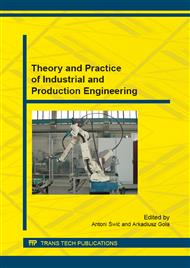[1]
A. Gola, Economical Aspects of Manufacturing Systems Design, Actual Problems of Economics, 156, 6 (2014) 205-212.
Google Scholar
[2]
G. Pedrielli, P. Scavardone, T. Tolio, M. Sacco, W. Terkaj, Simulation of complex manufacturing systems via HLA-based infrastructure, 25th ACM/IEEE/SCS Workshop on Principles of Advanced and Distributed Simulation (PADS) (2011).
DOI: 10.1109/pads.2011.5936772
Google Scholar
[3]
A. Gola, A. Świć, Computer-Aided Machine Tool Selection for Focused Flexibility Manufacturing Systems Using Economical Criteria, Actual Problems of Economics, 124, 10 (2011) 383-389.
Google Scholar
[4]
A. Świć, L. Mazurek, Modeling the reliability and efficiency of flexible synchronous production line, Eksploatacja i Niezawodnosc – Maintenance and Reliability, 52, 4 (2011) 41-48.
Google Scholar
[5]
M. Relich, A. Świć, A. Gola, A Knowledge-Based Approach to Product Concept Screening, Advances in Intelligent Systems and Computing, 373 (2015) 341-348, DOI: 10. 1007/978-3-319-19638-1_39.
DOI: 10.1007/978-3-319-19638-1_39
Google Scholar
[6]
M. Hajduk, P. Jenčik, J. Jezný, L. Vargovčik, Trends in industrial robotics development, Applied Mechanics and Materials 282 (2013) 1-6.
Google Scholar
[7]
J. Semjon, V. Baláž, M. Vagaš, Project multirobotic systems with KUKA robots in cooperation with VW Slovakia, in: L. Koukolová, A. Świć (Eds. ), Robotics and manufacturing systems, Lublin, 2014, pp.33-38.
Google Scholar
[8]
W. Kaczmarek, Elementy Robotyki Przemysłowej, WAT, Warszawa, (2008).
Google Scholar
[9]
A. Piotrowski, T. Nieszporek, Setting Up a Work Centre Based on the Profibus Network, Applied Mechanics and Materials, 282 (2013), 51-58.
DOI: 10.4028/www.scientific.net/amm.282.51
Google Scholar
[10]
M. Vagaš, Variants for the solution of multirobotic systems, in: L. Koukolová, A. Świć (Eds. ), Robotics and manufacturing systems, Lublin, 2014, pp.39-46.
Google Scholar
[11]
J. Honczarenko, Roboty Przemysłowe. Budowa i zastosowanie, Wydawnictwa Naukowo-Techniczne, Warszawa, (2004).
Google Scholar
[12]
Information on http: /www. theengineer. co. uk/manufacturing/automation/robot-revolution-humans-and-droids-working-together/1019569. article [Date of access: 22. 03. 2015].
Google Scholar
[13]
Information on http: /automatykaonline. pl/Z-branzy/UR3-nowy-robot-od-Universal-Robots [Date of access: 22. 03. 2015].
Google Scholar
[15]
Kawasaki Robot Materials, RS003NFE70 – Robot Specification.
Google Scholar
[16]
M. Halvorson, Microsoft Visual Basic 2010 Step by Step, Microsoft Press, Washington, (2010).
Google Scholar
[17]
Kawasaki Robot Materials, KCwinTCP-dll – Instruction Manual.
Google Scholar
[18]
Kawasaki Robot Materials, AS Language Programming.
Google Scholar


